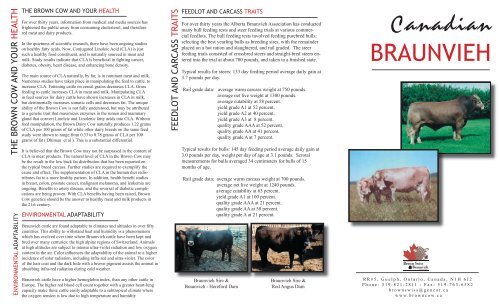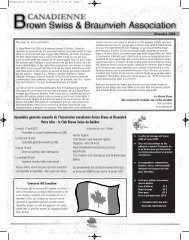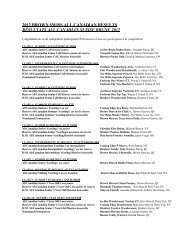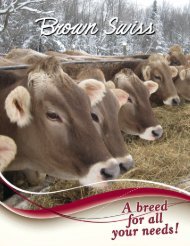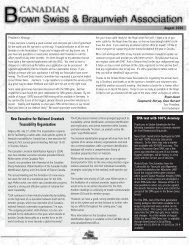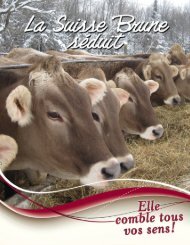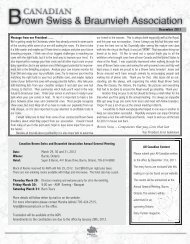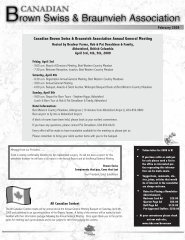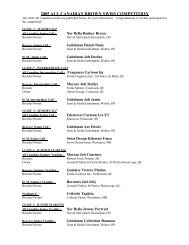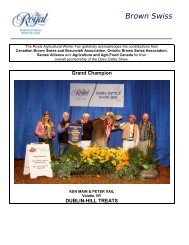Braunvieh Brochure.indd - Canadian Brown Swiss & Braunvieh ...
Braunvieh Brochure.indd - Canadian Brown Swiss & Braunvieh ...
Braunvieh Brochure.indd - Canadian Brown Swiss & Braunvieh ...
Create successful ePaper yourself
Turn your PDF publications into a flip-book with our unique Google optimized e-Paper software.
THE BROWN COW AND YOUR HEALTH<br />
ENVIRONMENTAL ADAPTABILITY<br />
THE BROWN COW AND YOUR HEALTH<br />
For over thirty years, information from medical and media sources has<br />
frightened the public away from consuming cholesterol, and therefore<br />
red meat and dairy products.<br />
In the quietness of scientifi c research, there have been ongoing studies<br />
on healthy fatty acids. Now, Conjugated Linoleic Acid (CLA) is just<br />
such a healthy food constituent, and is naturally sourced in meat and<br />
milk. Study results indicate that CLA is benefi cial in fi ghting cancer,<br />
diabetes, obesity, heart disease, and enhancing bone density.<br />
The main source of CLA naturally, by far, is in ruminant meat and milk.<br />
Numerous studies have taken place in manipulating the feed to cattle, to<br />
increase CLA. Fattening cattle on cereal grains decreases CLA. Grass<br />
feeding to cattle increases CLA in meat and milk. Manipulating CLA<br />
in feed sources for dairy cattle have shown increases in CLA in milk,<br />
but detrimentally increases somatic cells and decreases fat. The unique<br />
ability of the <strong>Brown</strong> Cow is not fully understood, but may be attributed<br />
to a genetic trait that maximizes enzymes in the rumen and mammary<br />
gland that convert Linoleic and Linolenic fatty acids into CLA. Without<br />
feed manipulation, the <strong>Brown</strong> Dairy Cow naturally produces 1.22 grams<br />
of CLA per 100 grams of fat while other dairy breeds on the same feed<br />
study were shown to range from 0.33 to 0.78 grams of CLA per 100<br />
grams of fat ( Dhiman et al ). This is a substantial differential.<br />
It is believed that the <strong>Brown</strong> Cow may not be surpassed in the content of<br />
CLA in meat products. The natural level of CLA in the <strong>Brown</strong> Cow may<br />
be the result in the low back fat distribution that has been reported on<br />
the typical breed carcass. Further studies are required to exemplify the<br />
cause and effect. The supplementation of CLA in the human diet redistributes<br />
fat to a more healthy pattern. In addition, health benefi t studies<br />
in breast, colon, prostate cancer, malignant melanoma, and leukemia are<br />
ongoing. Benefi ts to artery disease, and the reversal of diabetic complications<br />
are being proven. With CLA benefi ts having been raised, <strong>Brown</strong><br />
Cow genetics should be the answer to healthy meat and milk products in<br />
the 21st century.<br />
ENVIRONMENTAL ADAPTABILITY<br />
<strong>Braunvieh</strong> cattle are found adaptable to climates and altitudes in over fi fty<br />
countries. This ability to withstand heat and humidity is a phenomenom<br />
which has evolved over time where <strong>Braunvieh</strong> cattle have been kept and<br />
bred over many centuries: the high alpine regions of Switzerland. Animals<br />
at high altitudes are subject to intense ultra-violet radiation and low oxygen<br />
content in the air. Color infl uences the adaptability of the animal to a higher<br />
incidence of solar radiation, including infra-red and ultra-violet. The color<br />
of the hair coat and the dark hide with a brown pigment assists the animal in<br />
absorbing infra-red radiation during cold weather.<br />
<strong>Braunvieh</strong> cattle have a higher hemoglobin index, than any other cattle in<br />
Europe. The higher red blood cell count together with a greater heart-lung<br />
capacity make these cattle easily adaptable to a subtropical climate where<br />
the oxygen tension is low due to high temperature and humidity<br />
FEEDLOT AND CARCASS TRAITS<br />
FEEDLOT AND CARCASS TRAITS<br />
For over thirty years the Alberta <strong>Braunvieh</strong> Association has conducted<br />
many bull feeding tests and steer feeding trials at various commercial<br />
feedlots. The bull feeding tests involved feeding purebred bulls:<br />
selecting the best yearling bulls as breeding sires, with the remainder<br />
placed on a hot ration and slaughtered, and rail graded. The steer<br />
feeding trials consisted of crossbred steers and straight-bred steers entered<br />
into the trial at about 700 pounds, and taken to a fi nished state.<br />
Typical results for steers: 133 day feeding period average daily gain at<br />
3.7 pounds per day.<br />
Rail grade data: average warm carcass weight at 750 pounds.<br />
average net live weight at 1300 pounds.<br />
average cutability at 58 percent.<br />
yield grade A1 at 52 percent.<br />
yield grade A2 at 40 percent.<br />
yield grade A3 at 8 percent.<br />
quality grade AAA at 52 percent.<br />
quality grade AA at 41 percent.<br />
quality grade A at 7 percent.<br />
Typical results for bulls: 145 day feeding period average daily gain at<br />
3.0 pounds per day, weight per day of age at 3.1 pounds. Scrotal<br />
measurements for bulls averaged 34 centimeters for bulls of 15<br />
months of age.<br />
Rail grade data: average warm carcass weight at 700 pounds.<br />
average net live weight at 1240 pounds.<br />
average cutability at 63 percent.<br />
yield grade A1 at 100 percent.<br />
quality grade AAA at 21 percent.<br />
quality grade AA at 58 percent.<br />
quality grade A at 21 percent.<br />
<strong>Braunvieh</strong> Sire &<br />
<strong>Braunvieh</strong> - Hereford Dam<br />
<strong>Braunvieh</strong> Sire &<br />
Red Angus Dam<br />
<strong>Canadian</strong><br />
BRAUNVIEH<br />
R R # 5 , G u e l p h , O n t a r i o , C a n a d a , N 1 H 6 J 2<br />
P h o n e : 5 1 9 - 8 2 1 - 2 8 1 1 - F a x : 5 1 9 - 7 6 3 - 6 5 8 2<br />
b r o w n s w i s s @ g e n c o r . c a<br />
w w w . b r o w n c o w . c a
O R I G I N A S A B R E E D<br />
O R I G I N I N C A N A D A<br />
ORIGIN AS A BREED<br />
<strong>Braunvieh</strong> cattle belong to the worlds oldest breeds, as<br />
chronicled by offi cials of the <strong>Swiss</strong> <strong>Braunvieh</strong> Federation in<br />
Switzerland, considered the country of origin for brown cattle.<br />
Monastic records kept in the alpine areas of Central<br />
Switzerland confi rm these brown cattle were kept as a pure<br />
breed since the 13th century.<br />
Molecular Biologists defi ne a breed as a dynamic<br />
population of animals having:<br />
1.) Common genetic origin and history<br />
2.) Unique and distinctive characteristics<br />
3.) Genetic stability<br />
ORIGIN IN CANADA<br />
The Animal Pedigree Act for Canada regulates all species,<br />
including cattle breed associations in this country. The Act was<br />
fi rst passed by the Parliament of Canada in the 1900. The charter<br />
for a brown cattle breed association was granted the Federal<br />
Department of Agriculture in July of 1914. That was the beginning<br />
of the <strong>Canadian</strong> <strong>Brown</strong> <strong>Swiss</strong> Association. Breeders of this<br />
association bred and selected brown cattle for milk production<br />
purposes.<br />
The <strong>Canadian</strong> <strong>Brown</strong> <strong>Swiss</strong> Herd Book has the initial enrollment<br />
of 69 animals of the initial imports from Switzerland. This<br />
group was part of the original group of 129 animals that were<br />
imported by American Breeders into the New England States.<br />
No other Switzerland imports were enrolled into the Herd Book<br />
up until 1969, when importation from Europe resumed once<br />
again. This action was precipitated by a group of breeders in<br />
Alberta, intent on breeding and selecting brown cattle for beef<br />
production purposes.<br />
In 1996 the name of the association was changed to the <strong>Canadian</strong><br />
<strong>Brown</strong> <strong>Swiss</strong> and <strong>Braunvieh</strong> Association: this change was<br />
made to identify by name, the two phenotypes within the breed.<br />
B R A U N V I E H P H E N O T Y P E<br />
BRAUNVIEH PHENOTYPE<br />
The physical color characteristics are a single-colored grayish<br />
brown coat of varying pigmentation, from light to dark brown.<br />
Males tend to be darker than the females. A white ghost occurs<br />
around the muzzle.<br />
In the groin and under belly area, the hair color is also lighter than<br />
on the body. The elastic skin is pigmented, and the hair coat is fi ne<br />
and soft. The mucosa of the body orifi ces and the muzzle are black.<br />
The head is short but broad. The body has a straight top line, deep<br />
chest, and well sprung ribs. The dewlap is not emphasized. The<br />
underline is often parallel to the back. The hind quarters are long<br />
and wide, with the muscles carried down to the hocks. The legs are<br />
well muscled and possess strong bones, with hooves hard and dark<br />
colored. Mature animals in Canada will generally range between<br />
1300 to 1400 pounds for females, and between 1900 to 2200 pounds<br />
for males.<br />
MILK & MATERNAL CHARACTERISTICS AND CONVENIENCE TRAITS<br />
MILK & MATERNAL CHARACTERISTICS<br />
AND CONVENIENCE TRAITS<br />
<strong>Braunvieh</strong> and <strong>Braunvieh</strong>-cross females are excellent mother<br />
cows, and maintain a good milking ability. They have well attached<br />
udders with well placed teats that provide ample milk to<br />
their calves over the 180 to 200 day nursing period. In general,<br />
the milking ability results in higher weaning weights. It has<br />
been shown that sixty percent for the possible difference in<br />
weaning weight was due to milk and twelve percent is due to<br />
birth weight. This makes the <strong>Braunvieh</strong> cow a highly desirable<br />
maternal animal. Feedlot tests have shown that a higher weight<br />
per day of age at weaning resulted generally in higher average<br />
daily gains on feed.<br />
<strong>Braunvieh</strong> and <strong>Braunvieh</strong>-cross cows are noted for easy<br />
calving, even though birth weights are high: ranging from 80<br />
pounds to 120 pounds in the temperate <strong>Canadian</strong> climate. This<br />
range of birth weights tends to go down as the cattle are kept<br />
and bred and raised in lower latitudes: approximately on average<br />
by one pound for each degree reduction in latitude.<br />
The <strong>Braunvieh</strong> and <strong>Braunvieh</strong>-cross mother cows are noted<br />
for their docile nature and easy handling. This is boon to the<br />
cow-calf operator who is looking at every benefi cial aspect<br />
possible. <strong>Braunvieh</strong> cows and bulls are long lived. Some cows<br />
have been known to have a productive life up to twenty years<br />
of age: although this is more the exception rather than the rule.<br />
Some bulls have been known to have been active breeders in<br />
natural service up to fi fteen years of age: although this is more<br />
the exception rather than the rule.


